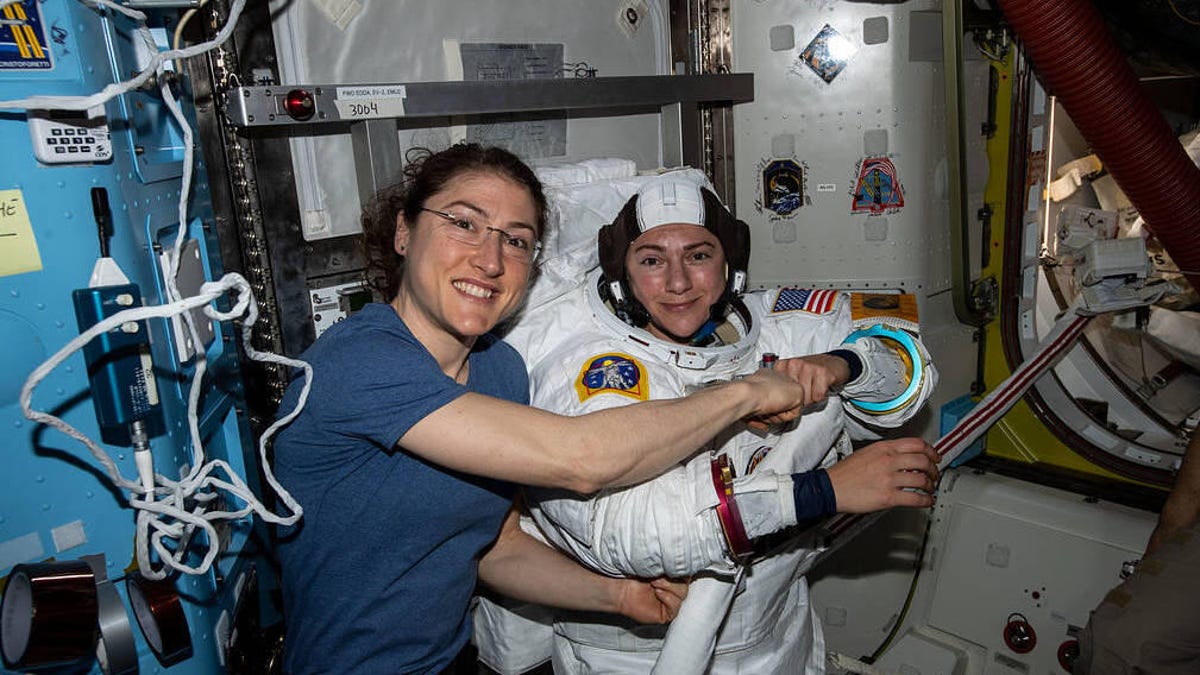In 2019, women helped redefine everything we know about space
When it comes to space travel, women were traditionally hidden figures. 2019 changed that and then some.

NASA's Christina Koch and Jessica Meir went on a spacewalk together in October 2019.
Here's to the Katherine Johnsons, the Valentina Tereshkovas, the Nancy Romans, the Sally Rides, the Mae Jemisons. NASA astronauts Christine Koch and Jessica Meir stand with you. The Artemis program and ESA's Mars rover stand with you. This year has been a tribute to and celebration of women and their ever-expanding roles in space exploration.
Female scientists and their contributions have long been marginalized. See Hidden Figures, the story of three black women who worked as "human computers" at NASA, for a crash course on how this veiled history is still coming to light. The accomplishments of women in space in 2019 is helping to correct the course of this narrative.
Here are some of the highlights from a year full of momentous occasions.
February: ESA names Mars rover for Rosalind Franklin
This illustration shows the ExoMars rover on Mars.
Rosalind Franklin's name will be launching to Mars in 2020. Franklin was a brilliant scientist who contributed to our understanding of the molecular makeup of DNA and RNA. Her work was only more widely recognized after her death in 1958. The European Space Agency selected her name out of over 36,000 responses to a naming contest for its ExoMars rover.
"It's fitting that the robot bearing her name will search for the building blocks of life on Mars, as she did so on Earth through her work on DNA," said Alice Bunn, international director of the UK Space Agency.
April: Katie Bouman and the black hole
The first-ever image of a black hole captured with the planet wide virtual array called the Event Horizon Telescope (EHT). The light is being pulled into the black hole at the center of the Messier 87 galaxy over 50 million light years away.
The first-ever image of a black hole blew humanity's collective mind. MIT grad Katie Bouman, now an assistant professor at Caltech, became the face of the team behind the image when a picture of her delight at first seeing the black hole spread across social media. Bouman helped develop a computer program that was used in the black hole image-creation process.
Here's the moment when the first black hole image was processed, from the eyes of researcher Katie Bouman. #EHTBlackHole #BlackHoleDay #BlackHole (v/@dfbarajas) pic.twitter.com/n0ZnIoeG1d
— MIT CSAIL #NeurIPS2019 (@MIT_CSAIL) April 10, 2019
Lest you think 2019 was all about space triumphs for women, we must also remember how online trolls went on the attack against Bouman and questioned her contributions to the black hole effort.
Bouman's work was real, and she was quick to credit the huge team behind the breakthrough: "No one algorithm or person made this image, it required the amazing talent of a team of scientists from around the globe and years of hard work to develop the instrument, data processing, imaging methods, and analysis techniques that were necessary to pull off this seemingly impossible feat," she wrote on Facebook on April 10.
Bouman's sudden fame also showed just how many people were looking for a female scientist role model to focus on. Dr. Bouman was absolutely worthy.
April: Christina Koch aims for space record
Astronaut Christina Koch aboard the ISS in July 2019.
NASA astronaut Christina Koch arrived at the International Space Station in March on her first mission to space. In April, NASA extended her planned stay all the way into February 2020, which will set a record for the longest single spaceflight by a woman. Koch's 328 days will come in just shy of NASA astronaut Scott Kelly's 340-day record set in 2016.
May: NASA announces Artemis
NASA created this new Woman on the Moon logo for the Artemis program.
"We're excited to be landing the first woman and next man on the surface of the Moon by 2024," NASA administrator Jim Bridenstine tweeted in May when the space agency formally announced the Artemis moon program.
In Greek mythology, Artemis is the twin sister of Apollo. It was a fitting name choice for a program that hopes to return humans to the moon for the first time since 1972.
NASA has made it a point to highlight its intention to send a woman to the lunar surface. Bridenstine even suggested NASA would consider an all-female crew.
June: NASA honors Hidden Figures
The street in front of the NASA Headquarters building is now known as Hidden Figures Way.
NASA renamed the street in front of its Washington, DC headquarters to Hidden Figures Way in honor of Katherine Johnson, as well as the late Dorothy Vaughan and the late Mary Jackson. The scientific accomplishments of these three black women were belatedly and widely recognized through the 2016 book and movie adaptation Hidden Figures. The trio of mathematicians worked for NASA (and its predecessor NACA) during the pivotal space race era of the 1950s and 1960s.
October: First all-female spacewalk
NASA astronauts Jessica Meir and Christina Koch posed for a photo together on the ISS.
On Oct. 18, NASA astronauts Christina Koch and Jessica Meir stepped out into the vacuum of space and made history on the first all-woman spacewalk. The pair worked on ISS maintenance tasks. Getting to this moment took some effort. The first all-female spacewalk was originally scheduled for March, but a spacesuit sizing issue forced a change of plans.
"To all those reaching to new heights: yes you can," Koch later tweeted.
To all those reaching to new heights: yes you can. #AllWomanSpacewalk pic.twitter.com/sPqfcK2ULy
— Christina H Koch (@Astro_Christina) October 20, 2019
"We're in sort of a new chapter now where we've crossed that line and two women have done it," said Koch in a post-spacewalk broadcast. "Now hopefully it will become commonplace and it won't even necessarily be something that's a big deal down the road."
Ultimately, that's the dream.

